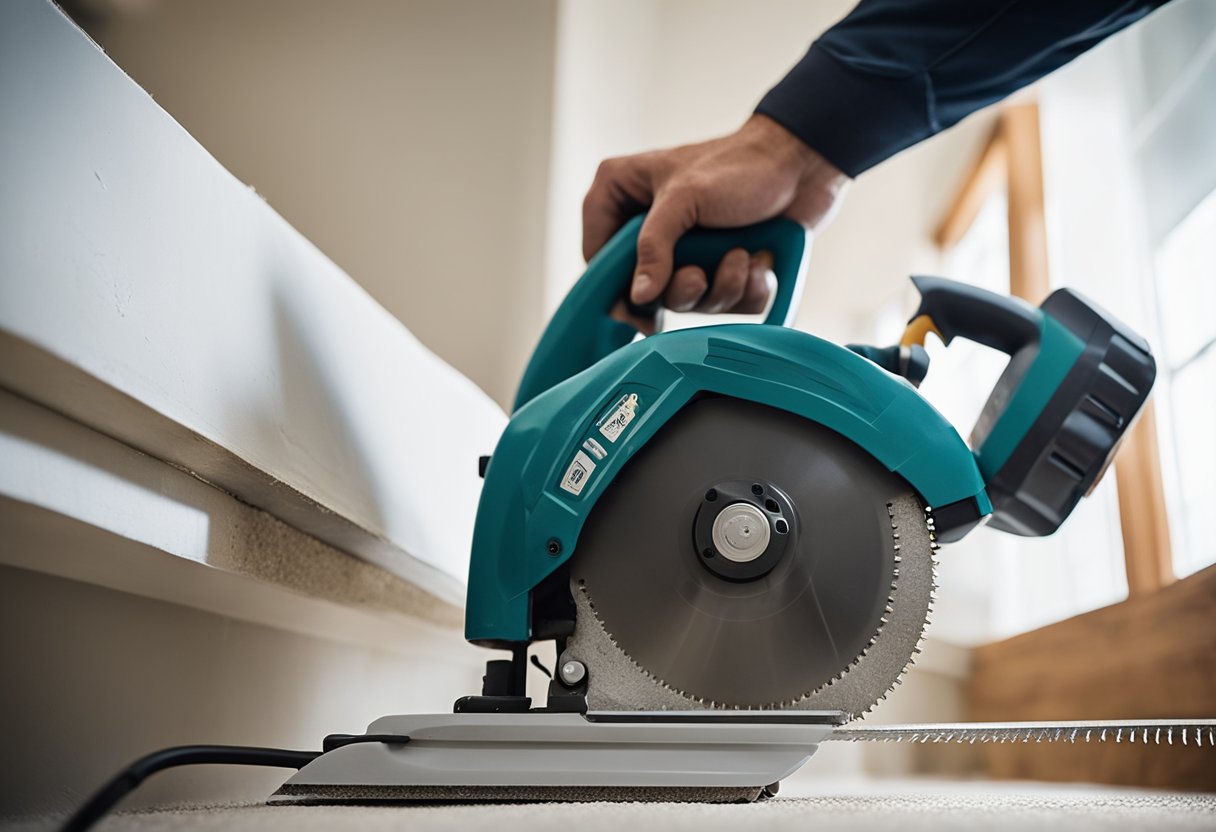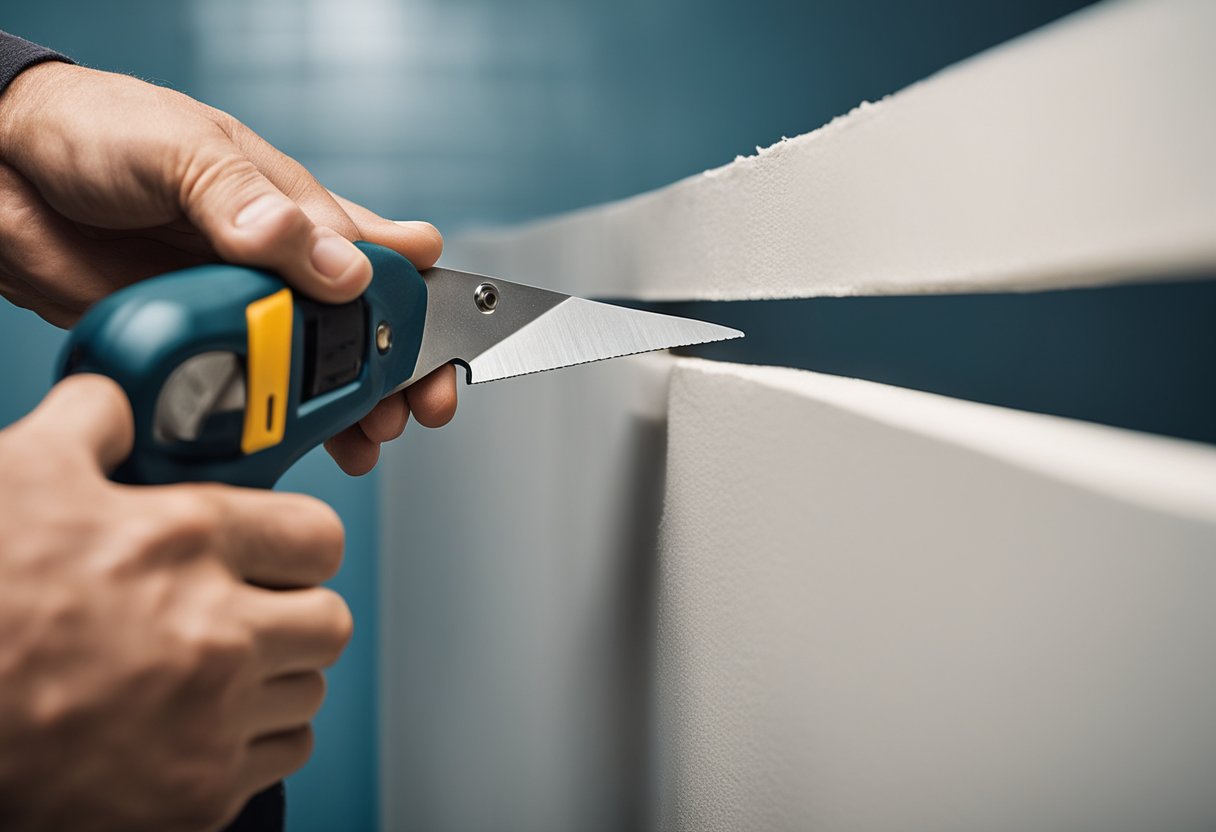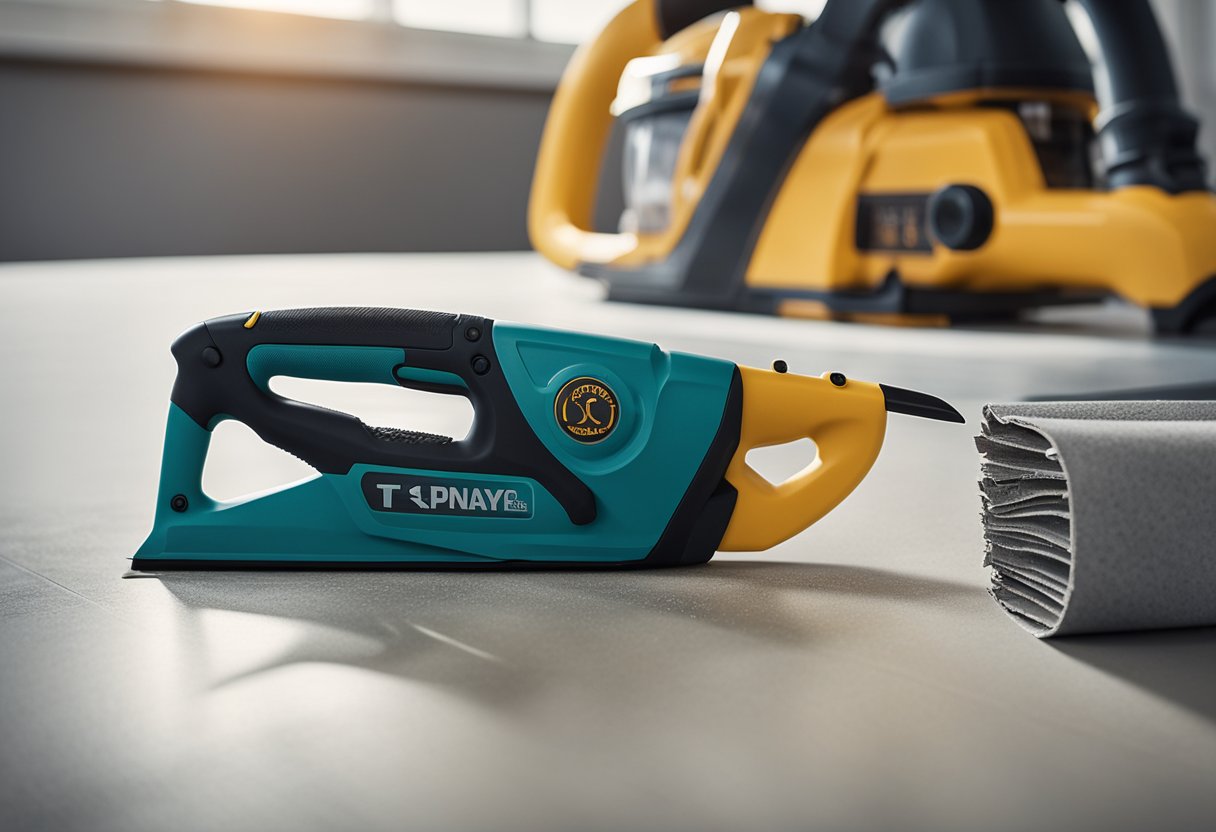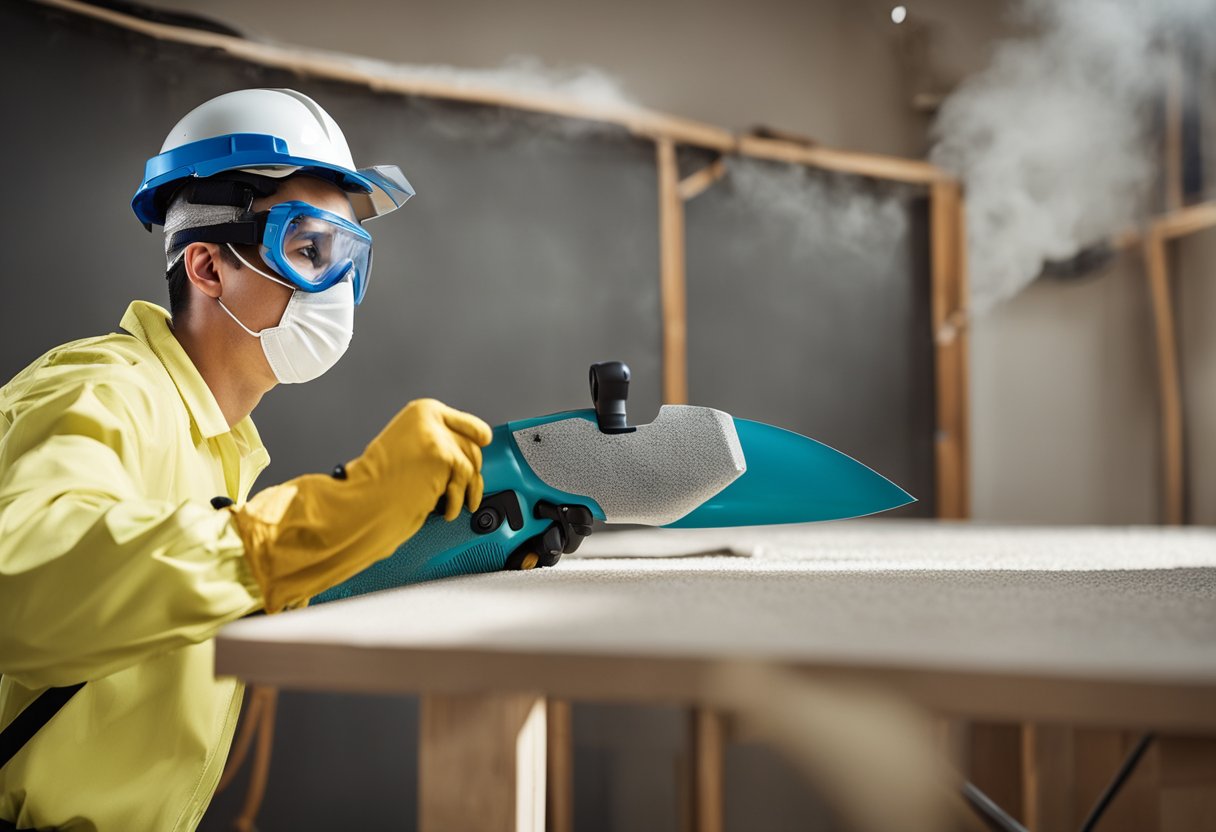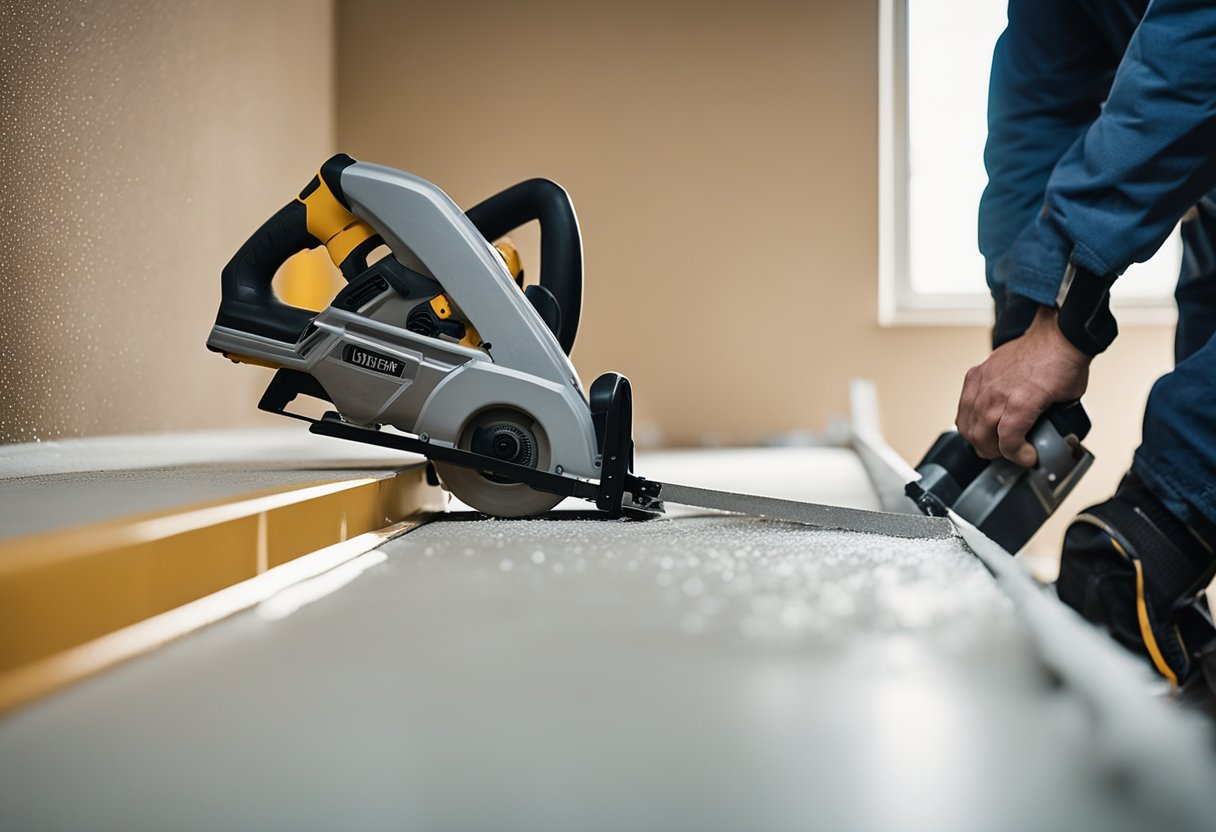Cutting drywall can be a messy and dusty process, but it doesn’t have to be. With the right tools and techniques, you can cut drywall without creating a cloud of dust that settles throughout your home. In this article, I will share my knowledge and experience on how to cut drywall without dust.
First, it’s important to understand what drywall is and its components. Drywall, also known as gypsum board or plasterboard, is a construction material used to create walls and ceilings. It consists of a gypsum core sandwiched between two layers of paper or fiberglass. The gypsum core is what gives drywall its rigidity and strength. When drywall is cut, the gypsum core is exposed, and that’s where the dust comes from.
Key Takeaways
- Understand what drywall is and its components
- Use essential tools for cutting drywall
- Follow safety measures during drywall cutting
Understanding Drywall and Its Components
When it comes to home renovation and construction projects, drywall is one of the most commonly used materials. Drywall is made up of gypsum, which is a soft sulfate mineral that is commonly found in sedimentary rocks. The gypsum is then mixed with water and other additives to create a slurry that is poured onto a paper backing. The paper backing is then sandwiched between two layers of gypsum core. This sandwiched structure is what gives drywall its strength and durability.
The paper used in drywall is an important component as well. It serves as a barrier to prevent moisture from penetrating the gypsum core, which can cause the drywall to deteriorate over time. The paper also provides a smooth surface that is easy to paint and finish.
Sheetrock is a brand name for drywall that is commonly used in the United States. However, sheetrock is not the only brand of drywall available. There are many different brands of drywall, each with its own unique features and benefits.
It is important to understand the components of drywall when working with it, especially when it comes to cutting it. Cutting drywall can create a lot of dust, which can be harmful to your health if inhaled. That’s why it’s important to take precautions to minimize the amount of dust that is created when cutting drywall.
Essential Tools for Cutting Drywall
Cutting drywall can be a dusty and messy job, but with the right tools, it can be done cleanly and efficiently. Here are some essential tools you will need to cut drywall without creating a lot of dust:
1. Utility Knife
A utility knife is a must-have tool for cutting drywall. It is perfect for making straight cuts and scoring the drywall to create a clean break. Make sure to use a sharp blade to ensure a clean cut.
2. Jab Saw
A jab saw is another essential tool for cutting drywall. It is designed to cut through the drywall quickly and easily, without creating a lot of dust. The saw has a sharp point that allows you to make a hole in the drywall, and then you can use the blade to cut along the line.
3. Drywall Square
A drywall square is a tool that helps you make straight cuts in the drywall. It is a T-shaped tool that has a ruler on one side and a 90-degree angle on the other. You can use it to mark the drywall and then cut along the line with a utility knife or jab saw.
4. Rasp
A rasp is a tool that helps you smooth out the edges of the drywall after you have made a cut. It is a rough file that can be used to remove any rough edges or bumps on the drywall.
5. Multi-Tool
A multi-tool is a versatile tool that can be used for a variety of tasks, including cutting drywall. It can be used with a drywall saw blade, a metal-cutting blade, or a wood-cutting blade. It is perfect for making precise cuts and can also be used to sand the edges of the drywall.
6. Circular Saw
A circular saw is a power tool that can be used to cut drywall quickly and efficiently. It is perfect for cutting large pieces of drywall and can be used with a metal-cutting blade or a wood-cutting blade. Make sure to use a dust collection attachment to minimize the amount of dust created.
7. Oscillating Multi-Tool
An oscillating multi-tool is another versatile tool that can be used for cutting drywall. It can be used with a drywall saw blade or a wood-cutting blade and is perfect for making precise cuts. It can also be used to sand the edges of the drywall.
8. Reciprocating Saw
A reciprocating saw is a power tool that can be used to cut through drywall quickly and efficiently. It is perfect for cutting large pieces of drywall and can be used with a drywall saw blade or a metal-cutting blade. Make sure to use a dust collection attachment to minimize the amount of dust created.
9. Tape Measure
A tape measure is an essential tool for measuring and marking the drywall before making a cut. Make sure to measure twice and cut once to ensure an accurate cut.
10. Drywall Router
A drywall router is a tool that can be used to cut holes in drywall for electrical boxes, outlets, and switches. It is perfect for making precise cuts and can be used with a variety of bits to create different size holes.
With these essential tools, you can cut drywall cleanly and efficiently, without creating a lot of dust. Make sure to use the right tool for the job and take the necessary safety precautions when using power tools.
Safety Measures During Drywall Cutting
When cutting drywall, it is important to take safety measures to protect yourself from dust and debris. Here are some tips to help you stay safe:
Wear Protective Gear
Before you start cutting, make sure you are wearing appropriate protective gear. A respirator will protect you from inhaling dust particles, while safety goggles will protect your eyes from flying debris. Wearing gloves can also help protect your hands from cuts and scratches.
Keep Your Work Area Clean
Keeping your work area clean is another important safety measure. Sweep up any debris and dust before you start cutting, and make sure to dispose of it properly. This will help prevent slips and falls, and reduce the amount of dust in the air.
Use the Right Tools
Using the right tools is key to cutting drywall safely. A utility knife with a sharp blade is a good choice for making precise cuts. Power tools like saws and routers can generate a lot of dust, so use them only when necessary and wear protective gear.
Cut Slowly and Carefully
When cutting drywall, it’s important to take your time and cut slowly and carefully. Rushing can lead to mistakes and accidents. Make sure your blade is sharp and take breaks when you need them.
By following these safety measures, you can help protect yourself from dust and debris when cutting drywall.
Preparation Steps for Cutting Drywall
Cutting drywall can be a messy and dusty process, but with proper preparation, you can minimize the amount of dust created. Here are some steps that I follow to prepare for cutting drywall:
Step 1: Take Accurate Measurements
Before cutting drywall, it’s important to take accurate measurements using a tape measure. Measure your cut and mark a cut line on your drywall using a carpenter pencil or marker. Double-check your measurements before marking your drywall to avoid unwanted material wastage.
Step 2: Use a Chalk Line
Using a chalk line is a great way to ensure a straight cut. Simply snap the chalk line along the cut line and use it as a guide for your cutting tool.
Step 3: Install Drywall Properly
Proper installation of drywall is key to reducing the amount of dust created when cutting. Use screws instead of nails to attach the drywall to the studs, as they create less dust. Make sure to leave a small gap between the drywall and any door or window openings to allow for expansion and contraction.
Step 4: Cut Electrical Boxes and Outlets
When cutting around electrical boxes or outlets, it’s important to turn off the power to the area before making any cuts. Use a drywall saw or rotary tool to carefully cut around the box or outlet, making sure not to damage any wires.
By following these preparation steps, you can cut drywall without creating excessive amounts of dust. Remember to always wear a mask and eye protection when cutting drywall to protect yourself from any dust or debris that may be created.
Cutting Drywall without Dust
https://www.youtube.com/watch?v=HIUJrc_HRfU&embed=true
Cutting drywall can be a messy job, but it doesn’t have to be. As someone who has cut my fair share of drywall, I have found a few ways to minimize dust and keep the job clean. Here are some tips on how to cut drywall without dust.
Use the Right Tools
Using the right tools can make a big difference in reducing dust when cutting drywall. One of the best tools for cutting drywall without dust is an oscillating multi-tool with a dust extraction kit. The dust extraction kit is attached to the oscillating handheld tool to collect dust during the cutting process. Then it passes the dust to the vacuum through the shop vac hose to ensure a dust-free drywall cutting experience.
Zip-Wall
Another tool that can help reduce dust when cutting drywall is the Zip-Wall. The Zip-Wall is a temporary barrier system that can be set up around the work area to prevent dust from spreading. It is easy to set up and can be used in conjunction with a dust extraction system to keep the area clean.
Wet Sanding
Wet sanding is another way to cut down on dust when finishing drywall. Wet sanding involves using a wet sponge or sandpaper to sand the drywall. The water helps to keep the dust down and makes it easier to clean up. Just make sure to use a wet/dry vacuum to clean up the water and debris.
Drywall Vacuum Sander
If you have a lot of drywall to sand, a drywall vacuum sander can be a great investment. These sanders attach to a shop vac and have a built-in dust collection system. They can be used for both sanding and vacuuming, making the job faster and cleaner.
In conclusion, cutting drywall without dust is possible with the right tools and techniques. Using an oscillating multi-tool with a dust extraction kit, the Zip-Wall, wet sanding, and a drywall vacuum sander can all help to minimize dust and keep your work area clean.
Post-Cutting Procedures
Once you have finished cutting the drywall, it is important to take some post-cutting procedures to ensure that you have a clean and smooth finish. These procedures include sanding, taping, and applying joint compound.
Sanding
Sanding is an essential step in achieving a smooth finish on your drywall. After cutting, use a sanding sponge to smooth out any rough edges or bumps on the surface of the drywall. Be sure to wear a mask to avoid inhaling any dust particles.
Taping
Taping is the process of applying a joint tape to the seams between drywall sheets. This helps to create a seamless surface and prevent any cracks from forming. Apply the tape to the seams and use a putty knife to smooth out any air bubbles or wrinkles.
Joint Compound
After taping, apply a joint compound to the seams and screw holes. This helps to fill any gaps or imperfections in the surface of the drywall. Use a putty knife to smooth out the compound and let it dry completely before sanding.
It is important to note that cutting drywall can produce a lot of dust, which can be harmful if inhaled. Be sure to wear a mask and use a dust collection system if using a power saw or drill. Additionally, silica dust is a known carcinogen and should be avoided. Always follow safety guidelines when working with drywall.
By following these post-cutting procedures, you can ensure that your drywall has a clean and smooth finish.
Frequently Asked Questions
https://www.youtube.com/watch?v=N_YTNoLKnqs&embed=true
What tools can be used to cut drywall without creating dust?
There are several tools that can be used to cut drywall without creating dust. One of the best tools is a drywall saw. This saw has a serrated edge that can easily cut through drywall without creating a lot of dust. Another tool that can be used is a rotary tool with a drywall cutting bit. This tool can be used to make precise cuts in drywall without creating a lot of dust.
What is the best way to remove drywall without creating dust?
The best way to remove drywall without creating dust is to use a utility knife to score the drywall along the studs. Once the drywall is scored, it can be easily removed by pulling it away from the studs. If the drywall is attached to the studs with screws, the screws can be removed using a drill with a screwdriver bit.
How can I cut drywall cleanly?
To cut drywall cleanly, it is important to use the right tools. A drywall saw or rotary tool with a drywall cutting bit can be used to make precise cuts in drywall. It is also important to measure and mark the cut line accurately before cutting.
What is the easiest way to remove drywall without damaging studs?
The easiest way to remove drywall without damaging studs is to use a utility knife to score the drywall along the studs. Once the drywall is scored, it can be easily removed by pulling it away from the studs. If the drywall is attached to the studs with screws, the screws can be removed using a drill with a screwdriver bit.
How can I protect drywall from dust when cutting?
To protect drywall from dust when cutting, it is important to use a dust mask and safety glasses. It is also helpful to cover the surrounding area with plastic sheeting to prevent dust from spreading. Additionally, using a vacuum with a HEPA filter can help to capture dust as it is created.
What is the best way to reuse plasterboard after cutting?
The best way to reuse plasterboard after cutting is to use the cut pieces for smaller projects, such as patching holes or creating small shelves. Larger pieces can be used for insulation or as a backing for tile in wet areas. It is important to ensure that the cut pieces are free from dust and debris before reusing them.

Hi, I’m Sal Muller of Tooltrip.com. My DIY experience led me to understand essential power tools for home projects. Tooltrip.com guides enthusiasts and professionals in choosing right tools for any job. I provide concise top tool reviews for easier, efficient DIY.

